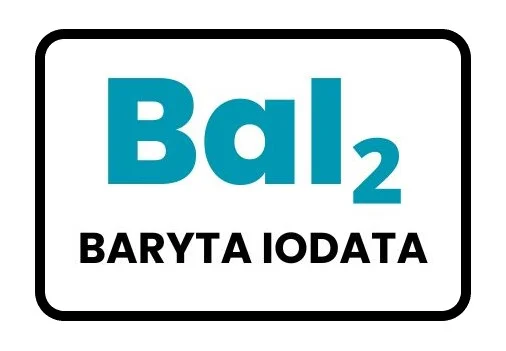Baryta Iodata, also known as Iodide of Baryta, is a homeopathic remedy that primarily affects the lymphatic system, leading to conditions such as quinsy, indurated glands, and various tumors.

SOURCE INFORMATION
- It is classified as an inorganic compound and is typically found as a white crystalline solid.
- Baryta Iodata is composed of two elements: barium (Baryta) and iodine (Iodatum) that is synthesized rather than obtained directly from a natural source.
- It is prepared through the reaction between barium carbonate (BaCO₃) and hydriodic acid (HI) or iodine (I₂).
- Its chemical formula is BaI₂, indicating that it contains one atom of barium (Ba) and two atoms of iodine (I).
- It is soluble in water and forms a colorless solution. In terms of its chemical nature, it is an ionic compound, consisting of positively charged barium ions (Ba2+) and negatively charged iodide ions (I-).
- Baryta Iodata has been used historically in homeopathy for its effects on glandular swellings, especially of the tonsils and breasts, and in cases of stunted growth and scrofulous ophthalmia.
DRUG PATHOGENESIS
- Baryta Iodata primarily acts on the lymphatic system, leading to increased leucocytosis (a rise in the number of white blood cells).
- It is indicated for conditions characterized by indurated glands, especially the tonsils and breasts.
- Additionally, it addresses tumefaction of cervical glands and stunted growth often associated with scrofulous ophthalmia.
KEY CHARACTERISTICS
- Quinsy (severe sore throat due to inflammation of the tonsils).
- Indurated glands, especially tonsils and breasts.
- Scrofulous ophthalmia (inflammation of the eyes associated with tuberculosis or similar conditions), with swelling of cervical glands.
RELATIONSHIP WITH OTHER DRUGS
- Compare: Acon lycotonum, Lapis albus, Conium, Mercurius iodatus, Carbo animalis.
DOSE
- Second and third trituration are recommended doses for Baryta Iodata in homeopathic practice.
Frequently Asked Questions
What is Baryta Iodata used for?
- Baryta Iodata, also known as Iodide of Baryta, is primarily used in homeopathy to address conditions affecting the lymphatic system, including quinsy (severe sore throat), indurated (hardened) glands, and various tumors.
How is Baryta Iodata prepared?
- Baryta Iodata is synthesized rather than obtained directly from a natural source.
- It is prepared through the reaction between barium carbonate (BaCO3) and hydriodic acid (HI) or iodine (I2).
What are the key characteristics of Baryta Iodata?
- Key characteristics of Baryta Iodata include its efficacy in addressing quinsy, indurated glands (especially tonsils and breasts), scrofulous ophthalmia (eye inflammation associated with tuberculosis), and tumors.
How does Baryta Iodata affect the lymphatic system?
- Baryta Iodata acts primarily on the lymphatic system, leading to increased leucocytosis (a rise in the number of white blood cells) and addressing conditions characterized by swollen or indurated glands.
What are the recommended doses of Baryta Iodata?
- In homeopathic practice, Baryta Iodata is typically administered in the form of second and third triturations, which are potentized dilutions of the substance.
What are the possible side effects of Baryta Iodata?
- As with any homeopathic remedy, side effects are rare due to the highly diluted nature of the substance.
- However, individuals with hypersensitivity to any of the components may experience adverse reactions.
Can Baryta Iodata be used during pregnancy or breastfeeding?
- It is advisable to consult with a qualified healthcare professional before using Baryta Iodata during pregnancy or breastfeeding to ensure safety and appropriate dosage.
How long does it take to see results with Baryta Iodata?
- The efficacy of Baryta Iodata may vary depending on the individual and the specific condition being treated.
- Some individuals may experience relief of symptoms relatively quickly, while others may require longer-term treatment for optimal results.
Meaning of Difficult Words
- Leucocytosis: An increase in the number of white blood cells.
- Indurated: Hardened or swollen.
- Tumefaction: Swelling or enlargement.
